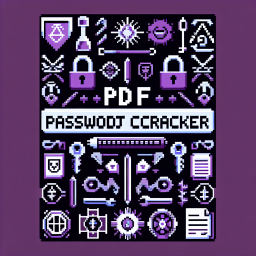
PDF Password Cracker
🔓 Can you crack the password protecting this confidential document?
📄 Master PDF password cracking techniques with specialized security tools
🔍 Learn dictionary attacks and systematic password breaking methodologies
💀 Over 80% of password-protected documents use weak, crackable passwords
🎯 Develop essential digital forensics skills for real-world security assessments
Start Your Challenge
This solution is for Flags Mode
This walkthrough explains how to hack the lab and capture the flags. For help with Learning Mode questions, use the Request Hint button next to each question.
PDF Password Cracker - Complete Solution Walkthrough
Understanding PDF Password Protection
PDF documents can be protected with user passwords (for opening) and owner passwords (for editing/printing restrictions). This challenge focuses on cracking a user password that prevents the document from being opened. PDF encryption typically uses RC4 or AES algorithms, but weak passwords remain vulnerable to systematic attacks regardless of the underlying encryption strength.
Step 1: Initial Analysis and Setup
- Download the PDF: Download the
secure_document.pdffile from the challenge page - Verify encryption: Try to open the PDF to confirm it requires a password
- Install tools: Set up PDF password cracking tools on your system
# Install John the Ripper (if not already available)
sudo apt-get install john
# Or install PDFCrack
sudo apt-get install pdfcrack
# Or use Hashcat for GPU acceleration
sudo apt-get install hashcatStep 2: PDF Password Cracking with PDFCrack
Method 1: Dictionary Attack with Common Passwords
- Basic dictionary attack: Try common passwords first
# Basic PDFCrack with common passwords
pdfcrack secure_document.pdf- Using a wordlist: Use a comprehensive password dictionary
# Download rockyou.txt wordlist
wget https://github.com/brannondorsey/naive-hashcat/releases/download/data/rockyou.txt
# Run PDFCrack with wordlist
pdfcrack secure_document.pdf -w rockyou.txt- Success result: The password is found to be
security123
Step 3: Alternative Tools and Methods
Method 2: John the Ripper
- Extract PDF hash: Use pdf2john to extract password hash
# Extract hash for John the Ripper
pdf2john secure_document.pdf > pdf_hash.txt
# Crack with John
john pdf_hash.txt --wordlist=rockyou.txt
# Show cracked passwords
john --show pdf_hash.txtMethod 3: Hashcat (GPU Acceleration)
- Use Hashcat for faster cracking:
# Convert to hashcat format and crack
pdf2john secure_document.pdf | cut -d: -f2 > hash.txt
hashcat -m 10500 hash.txt rockyou.txtMethod 4: Python Script
- Custom Python cracking script:
#!/usr/bin/env python3
import PyPDF2
import itertools
import string
def crack_pdf_password(pdf_path, max_length=10):
with open(pdf_path, 'rb') as file:
pdf = PyPDF2.PdfReader(file)
# Try common passwords first
common_passwords = ['password', 'admin', 'security123', '123456']
for password in common_passwords:
if pdf.decrypt(password):
return password
return None
password = crack_pdf_password('secure_document.pdf')
print(f"Password found: {password}")Step 4: Opening the PDF and Extracting the Flag
- Open with password: Use the cracked password
security123to open the PDF - Review content: The document contains a security assessment report
- Locate the flag: Search for the UUID-formatted flag within the document
# Use command line to extract text and find flag
pdftotext -upw security123 secure_document.pdf - | grep -E '[0-9a-f]{8}-[0-9a-f]{4}-[0-9a-f]{4}-[0-9a-f]{4}-[0-9a-f]{12}'- Flag extraction: The flag is clearly visible in the document content
Advanced Techniques and Considerations
Brute Force Attack Strategies
- Mask attacks: Target specific password patterns (e.g., ?l?l?l?d?d?d for letters+numbers)
- Rule-based attacks: Apply transformation rules to dictionary words
- Hybrid attacks: Combine dictionary words with number/symbol variations
Performance Optimization
- GPU acceleration: Use Hashcat with CUDA/OpenCL for faster cracking
- Distributed cracking: Use multiple machines for parallel password testing
- Smart wordlists: Use context-specific dictionaries (security, company names, etc.)
Security Implications and Defense
Why This Attack Succeeded
- Weak password: 'security123' follows common patterns and appears in wordlists
- Dictionary vulnerability: Password contains common words and simple number patterns
- Insufficient complexity: Lacks special characters and adequate length
Prevention Strategies
- Strong passwords: Use long, complex passwords with mixed characters
- Passphrases: Consider multi-word passphrases for better security
- Certificate-based protection: Use digital certificates instead of passwords
- Document rights management: Implement enterprise DRM solutions
Tools and Resources Summary
- PDFCrack: Specialized tool for PDF password recovery with dictionary support
- John the Ripper: Versatile password cracker with PDF hash support
- Hashcat: High-performance GPU-accelerated password cracking
- PyPDF2: Python library for PDF manipulation and password testing
- Wordlists: RockYou, SecLists, and custom dictionaries for attacks
Real-World Applications
- Digital forensics: Recovering passwords from seized encrypted documents
- Incident response: Accessing encrypted files during security investigations
- Penetration testing: Assessing document security in corporate environments
- Data recovery: Helping users recover access to forgotten password-protected files
- Security assessment: Evaluating organizational password policies and practices
Challenge Summary
This PDF Password Cracker challenge demonstrates the vulnerability of weak password protection on sensitive documents. Using common password cracking tools and techniques, attackers can systematically break weak passwords and gain unauthorized access to confidential information. The challenge emphasizes the critical importance of strong password policies, proper document encryption practices, and the need for organizations to implement robust document security measures beyond simple password protection.